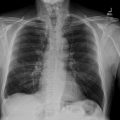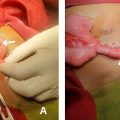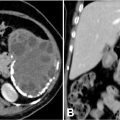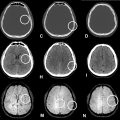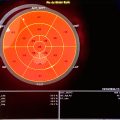Abstract
Pelvic digits (also known as pelvic fingers or pelvic ribs) are rare supernumerary benign bony lesions. Most of them are asymptomatic but, when symptomatic, they can pose a diagnostic challenge. We hereby present a case of a pelvic digit responsible for an organic erectile dysfunction and a disabling pain in the sitting position. Pelvic radiographs showed a 2-cm ossified cannulated structure emerging from the right ischiopubic ramus, extending down into the right perineal soft tissues.
MRI revealed a well-defined cortico-medullary digit with typical bone signal, developing near the hypertrophied root of the right corpus cavernosum and the insertion of the right adductor magnus muscle. The CT scan confirmed a pelvic digit with a pseudarthrotic single joint on the ischium. After a thorough 2-step surgical resection, pathologists confirmed the diagnosis. This particular radiologic challenge was to differentiate a pelvic digit from osteochondroma, avulsion-fracture sequelae, ligamentous calcification and myositis ossificans.
Introduction
A pelvic digit should be considered in the differential diagnosis of various ossified structures in the pelvis (osteochondroma, avulsion-fracture sequelae, ligamentous calcification and myositis ossificans). Very few of them are symptomatic and are often incidentally discovered. Relevant medical history such as previous trauma, hematoma, previous medical imaging and patients’ complaints are an essential guide to the diagnosis. We hereby report, according to our knowledge, the first case of an erectile dysfunction caused by a pelvic digit.
Case report
A 65-year-old farmer presented to the emergency department with right perineal pain, which worsened while sitting and during kneeling movements. The patient experienced significant discomfort while cycling or riding a motorcycle and he had decided to stop these activities many years ago. Medical history revealed a gnawing pain radiating to the right testicle and to the inferior inguinal area leading to an organic erectile dysfunction making it difficult to maintain a strong erection.
Given this clinical presentation, the initial hypothesis was pudendal neuralgia. Initially, a pelvic radiograph was prescribed, whose findings included a mature and cannulated 2-cm long bony protuberance attached to the right ischiopubic ramus, featuring an articulation at its origin, oriented toward the right perineal soft tissues ( Fig. 1 ).
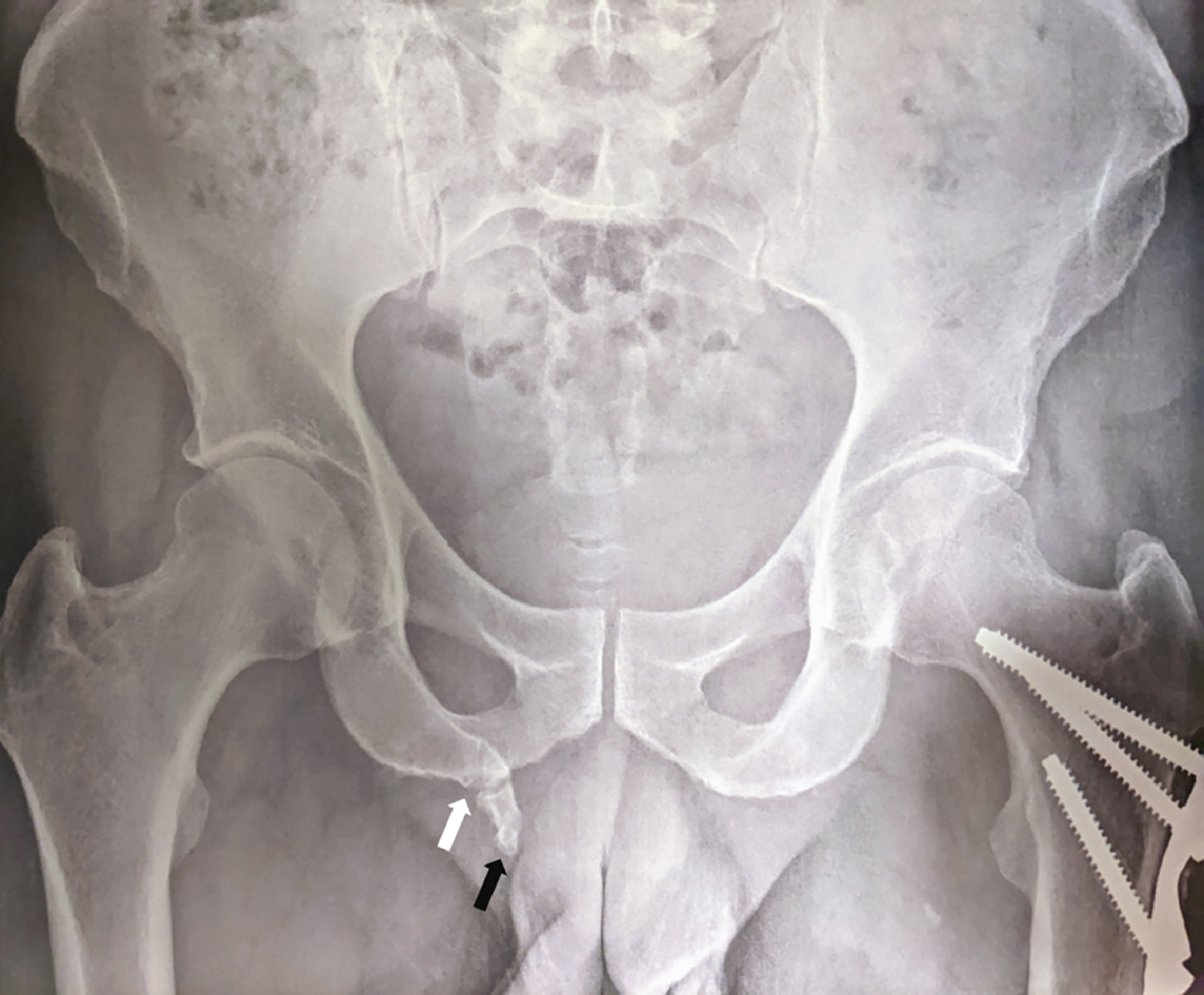
As an exostotic lesion was suspected, an MRI was performed later. It showed an oblong cortico-spongious structure emerging from the antero-inferior margin of the right ischiopubic ramus, showing the same signal as the adjacent bone, i.e. increased T1 signal, decreased T2 and STIR signal (24 mm high, 8 mm antero-posterior diameter, 7 mm thick) ( Fig. 2 ). It also confirmed the presence of a single joint with the right ischiopubic ramus and that one of its ends extended toward the bony insertion of the ipsilateral corpus cavernosum.
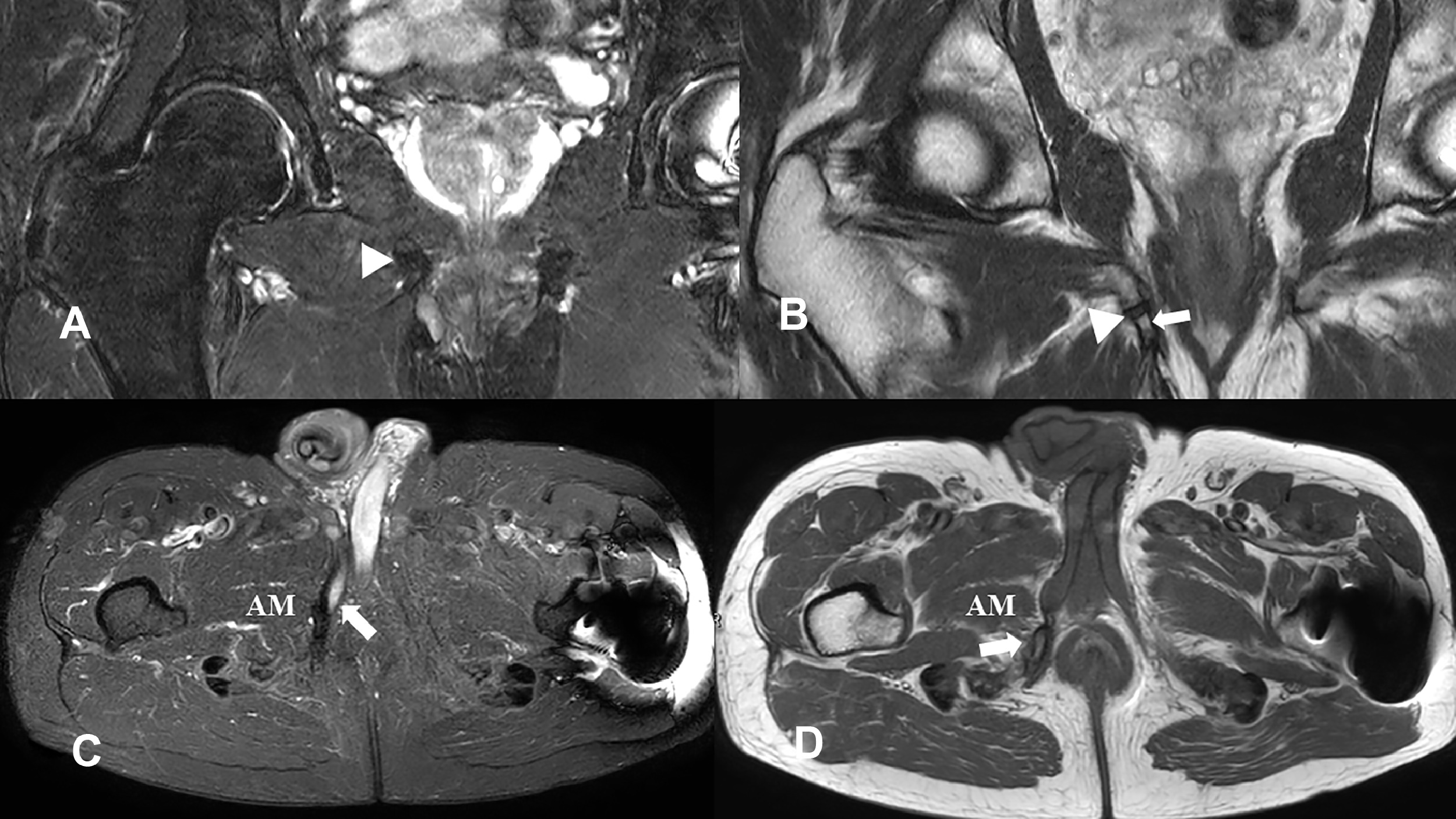
The right corpus cavernosum was hypertrophied compared to the contralateral side, which we hypothesized to be caused by the mechanical constraint exerted by the ossified structure. Furthermore, it was deforming the pubic insertion of the right adductor magnus. There were no peripherical high T2 signals, ruling out a cartilage cap and the differential of osteochondroma. A pelvic CT confirmed the diagnosis of a pelvic digit, in contact with the right ischiopubic ramus, demonstrating a fully ossified bone with no cartilaginous cap ( Fig. 3 ). The cortex of the ischium and the base of the pelvic digit formed a single pseudoarthrotic joint. Moreover, the CT confirmed a close relationship with the root of the right corpus cavernosum and the insertion of the right adductor magnus. It also revealed a focal infiltration of soft tissues surrounding the extremity of the digit, particularly in the hypodermic fat due to a chronic conflict in the sitting position. This specific symptom pattern is rarely observed. For this reason, we consulted a multidisciplinary team to assess the indication for surgical intervention, primarily to alleviate the patient’s pain. The patient initially declined the surgical intervention. Two and a half years later, he consulted the surgeon again because the pain had increased, radiating to the right iliac fossa and the right flank. The patient requested surgical removal of the lesion because sitting had become unbearable. As there were no contraindications, a 2-step surgical procedure was performed, enabling the removal of the pelvic digit with a 9-month interval between the surgeries. The procedure involved the use of Liston bone-cutting forceps after incising the right adductor aponeurosis ( Fig. 4 ).


